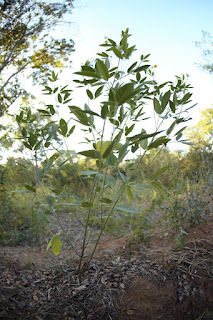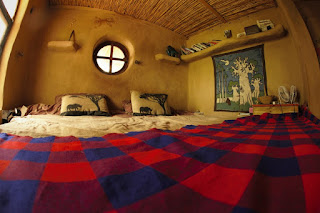It's been a while since i've had the time to post anything and people have been asking how the house is, our life here, so here is an update.
Our work as the Soft Foot Alliance is going really well, with many initiatives taking off in the less than 2 years we have been operating. Have a look at the facebook page for updates
The house is a dream come true, to wake up every day in these hand moulded walls feels sublime. The metal termite barrier works and checks are regularly done around the stone stem wall to check for tunnels to knock down. These beautiful photographs capture more of what we see and feel in our home, thanks to Brent for these.
 |
| we still share our home with many creatures who are welcome, such as this wasp nest. The wasps pollinate fruit trees and eat caterpillars so are more than welcome to take some plaster and make their nests. |
 |
| the banana circle with its compost pit fed only from grey water is producing bananas. |
 |
| for the fairies and the birds |
 |
| Nyimo (after our favorite indigenous legume) is a new addition to our home full of life, he goes into everything he does with 100% energy, inspiring. |
 |
| pawpaws growing |
 |
| We have 2 hives and love love love the bees! We have been learning about bee keeping as one of our conflict mitigation initiatives is to test out fences made of bee hives throughout the community to stop elephants raiding crops. This has had great results in Kenya and is a win win win, protect pollinators, increase crops, protect people and elephants, income generation from the sale of honey and wax products. |
 |
| winnowing amaranth seeds this has been a favorite leafy green throughout the rainy season and the seeds are a healthy grain to eat too. |
 |
| banana circle thriving with multiple species around the compost pit and grey water outlet, this microclimate is flourishing, full of worms, banana, pawpaw, chillies, comfrey, ridge gourd (for sponges) |
 |
| preparing materials for compost making, compost compost compost, in-situ beds or adding from piles building the soil is key. |
 |
| Amaranth |
 |
| Chia seeds, growing all over, bio-carbon has really helped to retain moisture and nutrients in some of the beds. |
 |
| rosella seeds fall to the ground and grow every rainy season, no need to replant every year. |
 |
| bees pollinating the pumpkins |
 |
| Sesbania fixing nitrogen |
 |
| Pigeon peas |
 |
| pigeon peas, moringa, sweet potato, chia, millets, cow peas, jelly melons, just a few of the species growing |
 |
| bees pollinating millet |
 |
| Tomatoes growing out of the humanure pile |
 |
| Terrible rainy season 2 months of high temperatures and no rain but some of the red maize survived, need to grow more of these as baboons don't like the colour! |
 |
| some indian millets |
 |
| Passive solar drier made from pallets |
 |
| chillies drying inside |
 |
| purple beans climbing a mango tree |
 |
| washing hands after 'completing the cycle' on the compost toilet, the water feeds an orange tree |
 |
| more of the creatures living in and around our home, we have seen more and more diversity as we regenerate |
 |
| Taro, the root is delicious, and needs a lot of water so grows in places like this next to the dog drinking bowl |
 |
| The many herbs growing in pots and wicking pots and beds, using very little water |
 |
| 20 litres of chilies collected so far this season |
 |
| cassava |
 |
| the wormery producing, composts and worm tea through the drain, a great fertilizer |
 |
| This rocket stove is almost 3 years old, we use it every day and it makes our lives so much easier, using just tiny sticks. More than 100 women have been trained by us to make these stoves and many have gone away to make more to sell. |
 |
| Our new years resolution is to go plastic free by the end of the year, this takes time to plan but creating a plastic free system doesn't have to be so hard. this is a hand cranked oil press and flour mill. Baking bread once or twice a week, using cloth bags to buy any produce anywhere, growing our own natural sponges are just some of the ways we are using to eliminate plastic from our lives and the environment. |


















































